“We found that adding low amounts of physical activity to one’s daily routine, such as 75 minutes of brisk walking per week, was associated with increased longevity: a gain of 1.8 years of life expectancy after age 40, compared with doing no such activity,” explained Harvard Medical School Professor of Medicine I-Min Lee.
75 minutes of walking per week is about 10 minutes per day, just think about it for a second. Just ten minutes per day increases your life expectancy, increases your health, and makes you feel better – talk about a great investment return.
While previous studies have shown the link between physical activity and a lower risk of premature mortality, the exact number of years added to the life expectancy was a mystery – until now. In a new study from Harvard-affiliated Brigham and Women’s Hospital (BWH), in collaboration with the National Cancer Institute, researchers have managed to quantify just how much life expectancy different levels of exercise can give you.
“Physical activity above this minimal level [10 minutes of walking daily] was associated with additional gains in longevity. For example, walking briskly for at least 450 minutes a week was associated with a gain of 4.5 years. Further, physical activity was associated with greater longevity among persons in all BMI groups: those normal weight, overweight, and obese.”
Researchers analyzed associations of leisure-time physical activity of a moderate to vigorous intensity for more than 650.000 subjects, following them for 10 years. The findings show a direct correlation between physical activity and longevity. Just by participating in low level of leisure time physical activity, you get a 19 percent reduced risk of mortality compared with no such activity.
“Our findings reinforce prevailing public health messages promoting both a physically active lifestyle and a normal body weight,” explained Steven C. Moore, research fellow at the National Cancer Institute and lead author of this study.
There you have it people; want to live a longer,healthier, life? Get out of the house and start doing something with your body – it really is as simple as that. Besides, you too can look as fine and be as photogenic as this guy.











